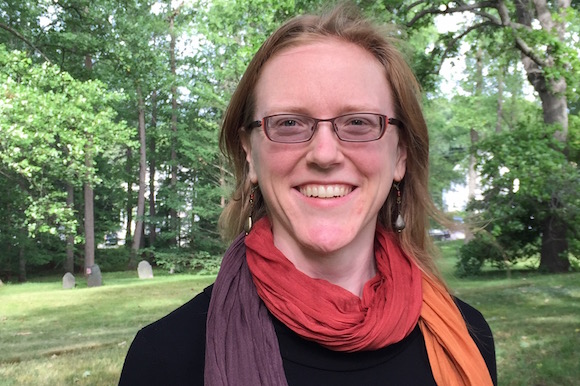CAMD recently welcomed Deirdre Loughridge, PhD, Assistant Professor of Musicology and Ethnomusicology, to its Music Department. She is a music historian who specializes in musical cultures of the eighteenth and nineteenth centuries, and in the history of music and technology. Her work engages with the history of science and media studies to illuminate music from material and multisensory perspectives.
In October, Professor Loughridge won an award from the Innovative Course Design Competition Committee and the Executive Board of the American Society for Eighteenth-Century Studies. One of her courses that she taught at her previous university, “Eighteenth-Century Origins,” was selected as a winner for 2016-17. After hearing this news, we sat down with Professor Loughridge to talk about her work here at Northeastern and what she is excited about accomplishing here in CAMD. Check it out below.
What are you teaching now? Describe the course and some of its features.
I’m currently teaching “Music in Everyday Life,” a brand new course designed to bring together our various music majors as well as non-majors, and provide an introduction to music studies and firm foundation for continuing musical pursuits (whether that means a career in music or a lifetime of musical enjoyment). We discuss a wide variety of music in this course, since there is a wide variety of music in our everyday lives and our surrounding musical cultures; and we develop a broad skillset for experiencing this music, interpreting it, and also for creating our own music. In fact, one of my favorite things about this course is that students approach music not only as listeners, but also as makers. If you have a laptop or smartphone, you are walking around with amazing recording capacities, sound editing software, and access to enormous repositories of music. So even for students who don’t have a musical performance or recording background, this course is a place to start experimenting with creating music – because creating music is an excellent way to hone listening skills, and gain experiential insight into creative processes and artist-listener relationships. And because this course rejects the notion that there are musicians and non-musicians. Certainly there are different levels of training and expertise. But I hope students leave this course thinking of “music in everyday life” not only in terms of the background soundtrack many of us experience on a daily basis, and in terms of the history of music’s influence on the social world, but also in terms of how we can make music out of the everyday stuff around us.
What are you teaching next semester?
In the spring I am teaching “40,000 Years of Music Technology.” We’ll study cases of music-technological innovation starting with the bone flute (the world’s oldest known instrument, dated to about 40,000 years ago) and ending somewhere around Auto-Tune and Vocaloid (software that does what was traditionally part of a human singer’s job). We’ll look at social and cultural reasons music technologies fail or succeed (having given some thought to what we mean by failure and success in music technology). And we’ll study how music and technology have shaped one another over their entwined, multi-millennial history.
Can students apply what they learn in your classroom to the professional music industry?
Absolutely. In my classes, I try to get students thinking about not only how music or the music industry works, but why it works that way. “Why” questions require thinking about music in relation to history and culture. And it’s that kind of critical, next-level thinking that empowers students not just to do a job well, but to create opportunities for themselves and work towards positive, industry-level change. With the speed at which the music industry and musical cultures are transforming, it is imperative that students learn to see the big picture and the many complex, interrelated factors that go into musical success. That’s why we do things like study a wide variety of musical practices, and analyze how the very same music can be perceived, valued and interpreted differently in different contexts.
What are you most excited about in your new role at Northeastern’s College of Arts, Media and Design?
So many things – the opportunity to teach innovative courses to students who bring a wide range of interests and backgrounds to the material; the opportunity to grow the new BA in music major – I hope in part through double majors, as I myself was a music and biology double major as an undergraduate; getting to work with colleagues who are also doing exciting research in their fields. I love the combination of creative practice and critical engagement that CAMD so eminently fosters.
What are a few of your favorite composers/artists from the 18th & 19th centuries? Feel free to name a few contemporary artists that you enjoy as well!
My 18th- and 19th-century favorites are terribly predictable – though I might give a shout-out to Haydn’s Il mondo della luna, a seldom performed opera I wrote about in my book Haydn’s Sunrise, Beethoven’s Shadow. The opera provides an 18th-century take on what the world on the moon would be like, and Haydn wrote particularly delightful music for the scenes of telescopic observation and exploring lunar nature. In contemporary music, I’ve enjoyed the recent albums from tUnE-yArDs and Thao & the Get Down Stay Down – two artists that are drawing together diverse influences in really interesting ways, and using their music not only to express themselves but also to address pressing social concerns.


